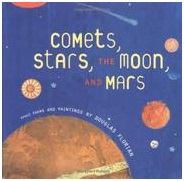Lai, Thanhha. 2011. INSIDE OUT & BACK AGAIN. New York: Harper Collins. ISBN 978-0-06-196278-3
Hà is just 10 years old when war comes to her home town in Vietnam. Hà’s free verse narrative opens in 1975 on New Year’s (called Tet) which “doubles as everyone’s birthday” (p. 2). Hà, her hard-working mother, and her three brothers spend the first part of the “Year of the Cat” struggling with the social and economic repercussions of the Vietnam War. The family makes the heartbreaking decision to flee Saigon on a crowded ship when war arrives at their doorstep. After leaving Vietnam, Hà and her refuge family take a circuitous route that ultimately leads them to Alabama. Hà and her family struggle with the radical change in customs, language, cuisine, and religion while progressively making a place for themselves in America.
Thanhha Lai flawlessly captures the naive perspective of a child with poetic and picturesque free verse in INSIDE OUT & BACK AGAIN. While the story of Hà and her family is tragic and heartbreaking, the narrative is still “shot through with humor” (Kirkus Review 2011). Through inexperienced and childlike eyes, “Hà misunderstands much about her new home” (Kirkus Review 2011). The book is filled with vividly picturesque details that only a child would find significant. For instance, Hà describes in infinitesimal detail the dizzyingly erratic changes in her cuisine (or lack of) throughout the book. Hà’s favorite food in Vietnam comes from a papaya tree she grew from a seed in her backyard. When confronted with papaya in America (p. 232):
NOT THE SAME
Three pouches of
Dried papaya
–
Chewy
Sugary
Waxy
Sticky
–
Not the same
at all.
–
So mad,
I throw all in the trash.
This story is perfectly targeted for a 9-12 year old’s understanding of the world. As the School Library Journal points out, “the intended reader neither knows or cares about the type of minutiae that an adult reader may expect from such a tale of flight and immigration” (Burns 2011).
Enrichment Activities:
Poetry can often be used to “serve as a jumpstart or introduce a lesson or topic, offer a transition between activities, provide closure, or extend the topic further” (Vardell 2008, 132-133). There are several themes in this novel that can be used for a “jumpstart” to topics such as immigration, the Vietnam War, different cultures/customs of the worlds, and racism/tolerance.
Children can also be guided in writing their own free verse story of events in their own life. Teachers or parents can share the following interview with Thanhha Lai. The interview examines how she became a “prose poet” and came to write this moving account of her tumultuous childhood: http://forum.teachingbooks.net/?p=10924 .
Lastly, I would like to remind readers that poetry is “meant to be read aloud” (Vardell 2008, 130). I leave you with this final video of Thanhha Lai reading a passage from INSIDE OUT & BACK AGAIN at the 2011 National Book Awards where she won best in Young People’s Literature:
What to Read Next:
Crossan, Sarah. 2013. THE WEIGHT OF WATER. New York: Bloomsbury. ISBN 978-1599909677
Hesse, Karen. 2009. OUT OF THE DUST. Orlando, FL: Great Source. ISBN 978-0590371254
References
Burns, Elizabeth. Review: Inside Out and Back Again. November 1, 2011. http://blogs.slj.com/teacozy/2011/11/01/review-inside-out-and-back-again/ (accessed February 21, 2014).
Kirkus Review. INSIDE OUT AND BACK AGAIN. January 15, 2011. https://www.kirkusreviews.com/book-reviews/thanhha-lai/inside-out-and-back-againh/ (accessed February 21, 2014).
Vardell, Sylvia M. CHILDREN’S LITERATURE IN ACTION: A LIBRARIAN’S GUIDE. Westport, CT: Libraries Unlimited, 2008.





